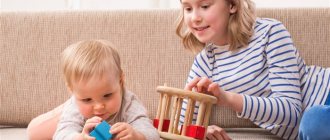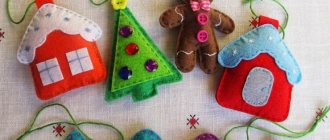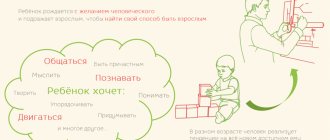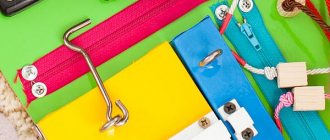Features of the development of a nine-month-old baby
The beginning of the tenth month of life is a special period; it is the last trimester of infancy. At this age, the baby experiences a powerful intellectual upsurge: simple interest in the environment is replaced by curiosity, now the baby does not just grab objects - he tries to carry out some manipulations with their help, and objective activity comes first. The brain masters mental operations, receiving information about the world around us through hand movements. It does not develop independently of the body, and mental development runs parallel to physical development.
Speech
The child becomes smart, understands the speech of adults well, and does not just catch intonation. Now he does not spontaneously reproduce sounds by babbling, but demonstrates his own speech activity: he masters new syllables and tries to imitate the intonation of adults.
Physical activity
Physically, the baby has also noticeably “matured.” You can no longer keep him in a crib or playpen. Now he can do things on his own for a long time: explore the apartment, crawling or using a walker, and some fidgets are already taking independent steps at this age.
It is very important that there is a designated play space for the baby in the house. Let it not be a separate room, but just a corner where you can lay a blanket and put toys. It’s great if it is possible to allocate a small children’s area in each room: in the living room with rattles and pyramids, in the kitchen with safe kitchen utensils (lids, plates, spoons), in the bathroom there is a shelf with rubber toys and empty shampoo bottles.
Emotions
At this age, the baby cannot play on his own for a long time; he needs a partner. It is very important that the baby receives from his parents the experience of showing emotions, experiences, and any actions in games together with them.
How to develop a child at 9 months?
“Raising a child early does not require parents to spend any extra time or money,” says Masaru Ibuka, author of the best-selling book for parents After Three It’s Too Late.
It is not necessary to have a pedagogical education in order to properly work with your baby, and there is also no need to enroll your baby in an early development school: at least fifteen years of study await him ahead! Let the baby stay little longer! After all, educational games for 9-month-old children at home are easy!
There are various methods of child development that promise parents who read a smart book that their child will become a genius. But you shouldn’t rush things by overloading your baby; activities should be age-appropriate! It is worth paying attention to all-round development: improving hearing, vision, developing speech, and physical abilities.
On the threshold of speech: learning to speak and understand an adult
Starting from 9 months, the baby begins to actively babble, pronouncing simple syllables, learns to imitate an adult, repeating syllables after him. At this age, the child understands the names of several objects, knows how to find and show them.
"Familiar Toys"
If your baby is familiar with two toys, add a new one to them. Place your baby in front of the toys and name the new toy out loud. Ask to show toys that are already familiar to him. Then, ask to see the new one. As soon as your baby completes this task, praise him. Swap the toys and start the game over.
"I'm rolling the ball"
This game will teach your child to perform simple actions and pronounce new syllables.
Sit on the floor, place your baby opposite. Read the poem, performing the movements, and the baby will imitate you:
We'll clap our hands - Clap-clap-clap! We'll clap our hands - Clap-clap-clap! We'll wave our hands - La-la-la! We'll wave our hands - La-la-la!
Place your baby on his feet against a support and continue:
We'll stomp with our feet. We'll stomp with our feet. We'll stomp with our feet. We'll dance with our feet, Yes, yes, yes! We'll dance with our feet, Yes, yes, yes!
This game develops understanding of plot actions and adds new sounds to the baby's vocabulary. Take the doll by the hands and move it, saying:
Get out of the way, cat, Our doll is coming, Stomp, stomp, stomp, stomp, stomp, stomp, Our doll is walking, She will never fall. Thump! Fell!
Games for speech development
By nine months, the child’s speech skills also change noticeably. The babbling becomes longer, a nine-month-old baby can already pronounce syllables with complex consonants, connects them into a speech chain, using different intonation and emotional colors. Interjections appear in his speech practice: “Ay”, “Oh”.
The baby knows his name, understands the meaning of the words “give”, “on”, “where?”, and knows how to perform some movements at the request of an adult. When he hears the word “okay,” he claps his hands or waves his hand “bye-bye” goodbye. Speech-developing games for a 9-month-old child will motivate speaking, enrich the baby’s passive vocabulary, train the articulatory apparatus, and develop phonemic hearing.
- “Little singer” - the mother should sing the syllables that the baby can already pronounce well: “Ma - ma - ma, pa - pa - pa - pa.” Hearing familiar sounds, the child begins to sing along.
- “Mom’s requests” - teach the baby to carry out small tasks: give mom a hand, bring a ball, roll a car, wave a hand. Gradually, requests should be made more complex, emphasizing the qualities and properties of objects: “Sasha, please give me a small car” or “Throw me a red ball.” At 9 months old, toys become an indispensable means of teaching speech.
- “Explainers” - first of all, the baby begins to pronounce words that indicate actions that are vital for him: drink, give, thump, yum - yum, walk. Therefore, they should be extremely simple and short, even down to onomatopoeia. With their help, we teach a 9-month-old child to express desires and needs.
Don't waste your time and energy on communicating, playing and talking with your children. Remember that children whose development their parents paid attention to grow up literate, harmoniously developed and successful.
Games that develop the first objective actions
The baby should get an idea of size, shape, and color in the first year of life. What games contribute to this?
- A variety of pyramids with rings of different sizes and colors, cubes, sorters - these are the toys a child should have. It is worth practicing for as long as the child remains interested in the game. The child is unlikely to learn how to handle such “didactic material” on his own - be sure to show him what to do.
- Get your baby's attention by calling his name or clapping your hands. Next, demonstrate the toy, show it from all sides, commenting: “what an interesting pyramid! And what bright rings she has!”
- First, assemble the pyramid yourself, without ceasing to comment on your actions. Allow your child to touch, even take the toy from your hands. It doesn't matter if he doesn't let you assemble the pyramid completely.
- The next stage is to do the work again, but this time with the child’s hands, holding them with your own hands, directing the movements.
- Next, when the baby understands what the essence of the game is, put the pyramid together, putting on the rings one by one. A few days - and the child will begin to assemble the toy himself: first chaotically, then arranging the parts in order.
With great pleasure, the baby tinkers with boxes, bowls, and buckets in which toys can be placed.
"Sorting"
A game in which objects need to be sorted according to certain criteria. Of course, the child is still small, but by regularly studying, very soon he will begin to put cubes in one box and books in another. A large single-seater nesting doll can be a good helper in this. Such toys allow the baby to explore the properties of space, volume and spaciousness.
“Everything that the baby does directly with his hands, with his hands - or draws, or scatters toys around the house, even when he just tears up paper - contributes to intellectual and creative development,” says Masaru Ibuka. “The sooner you give the pencils, the faster you will see results.”
Drawing
Drawing lessons can also be taught with finger paints. Drawing with your palms and fingers is useful for developing fine motor skills and imagination. You can spread a large sheet of paper on the floor or attach it to the wall, so it will be convenient for the baby to create masterpieces.
Skills of a 9-month-old baby
- The baby must be able to sit - confidently and without support.
- Can crawl on all fours.
- While sitting, the child can bend over and pick up the toy. The way of grasping objects changes at 9 months of age; now the baby grasps the object by closing the thumb and forefinger. This is the so-called tweezer grip. This skill allows the baby to lift small things.
- The child must be able to stand while holding onto support. Sometimes children start playing by squatting, standing or jumping.
- The baby must be able to climb over low obstacles and onto the sofa.
- The baby reacts well when his name is called and turns his head.
- A 9-month-old toddler should be able to pronounce not only vowels, but also consonants and syllables. The simplest method of developing a child’s speech is to talk to him, pronouncing all his actions, talking about objects and natural phenomena.
Games that normalize physical activity
Mom can become an excellent physical instructor. It would be a good idea to purchase fitballs and rubber balls of different sizes; by including game elements in gymnastics, you will already instill in your child a love of sports.
"Rolling, rolling"
A simple game that develops hand strength and coordination of the baby's movements. Place him opposite you at a distance of a meter and push the ball so that the child can catch it. You shouldn’t expect immediate response from the child, but after a few days this game will no longer be in the “one-goal” category. In addition, this game will teach your child to carry out simple instructions: roll, give.
Show the baby the ball and roll it around. Push the ball towards the baby and ask him to make a response. Accompany the game with poetry:
Roll my ball, Roll it again, Roll it there, Roll it here. Roll my ball, Come back! Look, don’t yawn, Give me the ball!
Rocking horse
A good simulator for developing balance and training the vestibular system. At first, the baby should swing only under adult supervision. It is better to buy such a toy according to height, so that the child’s legs reach the floor. But this game is only for those children who are excellent at sitting without support behind their backs!
If it is possible to install a children's horizontal bar at home, it will become a wonderful exercise machine for the muscle group of the arms and back.
"Pull-pull"
A game that develops shoulder muscles. Sit opposite the baby and give him the end of a long scarf in his hands, and pull the other end so that the child understands what you expect from him. Be sure to give in to your little partner, and when he pulls hard, you can even fall: this way the child will feel how joyful victory can be, and your “loss” will be rewarded with a happy laugh.
Physical exercise and sensory play contribute to overall muscle strengthening and develop attention and coordination.
“By ensuring that muscle function and coordination of movements become harmonious, the child will be ready for more complex skills, for example, walking,” states Jackie Silberg, author of the publication “125 Developmental Games for Up to a Year.”
How to develop a baby’s fine motor skills and why is it necessary?
Studies of the cerebral cortex have confirmed that the hand is a full-fledged organ of speech, since there is a close relationship between subtle movements of the fingers and speech function.
If you want your baby to learn to speak as quickly as possible, you need to train not only the articulatory apparatus, but also fine motor skills of the fingers.
And the sooner you start doing this, the sooner the results will be.
Simple finger games are not just physical activities with your child. You touch his body parts, pronounce sentences, wait for a response - and the child makes contact. This is a deeper communication than ordinary dialogue.
“Horned, butted goat”, “Ladushki” are the simplest of this category of educational games. You can also train your fingers while bathing, for example, by soaping your hands one at a time, massaging each finger, slightly sipping, repeating:
They washed this finger with soap, And they didn’t forget about this one. They washed it, washed it, rinsed it, Kissed each finger.
Before lunch, you can also play by putting a spoon in the hands so that the baby squeezes it with all his fingers. Unclench your fingers one by one and release them, saying:
The little one took this spoon for lunch! He fed this little finger, And he fed this one, And he didn’t forget about this one, And he gave it to the little finger. But the big one didn’t get it, Oh-oh-oh, what a pity!
You can even include finger games in the dressing process. When pulling on a T-shirt, first put one hand into the sleeve, stroking your palm, clench and unclench your fingers into a fist, saying:
What kind of nice kids are they playing hide and seek with the baby? Here they are (unclenching their fist), but here they are not (clenching them), Well, hello, baby, hello! (squeeze lightly and shake your palm).
Do the same with the other handle.
The development of fine motor skills is facilitated by games with beads (under supervision!), with cereals (bags packed with different types of cereals are convenient), construction sets, and large puzzles. And even if the toy is a little out of age, it can still be used creatively!
Developing intelligence
At 9 months, a child absorbs knowledge like a sponge, trying to understand the world around him. His brain masters basic mental operations: the baby can already think, perform basic analysis, and make inferences. He develops memory, attention and perception. Emotions become more conscious and richer. At 9 months, games with the child will come in handy, training ingenuity, memory, logical thinking and imagination.
- “Assemble a nesting doll” - for this activity you will need two open nesting dolls of different sizes. Invite your child to match the top of the toy to the bottom. For the first time, help your baby by drawing his attention to the difference in the size of the parts. The game trains the eye, the ability to analyze and compare objects, and also develops fine motor skills.
- “Hide and seek with toys” - put two toys in front of the baby: “Look, Maximka, here is a dog, and this is a car.” Cover each with a handkerchief: “Where is the machine, Maxim? Let's find the machine." This game will develop your child’s memory, attention, logical and spatial thinking. He will understand that those objects that are not visible at the moment do not disappear anywhere, and they can be easily found by pulling off the handkerchief.
- “Where is the dog?” - tie the toy animal on a long ribbon. Give the free edge to the baby sitting on the sofa. Hide the toy below. Ask to find the dog. After several unsuccessful attempts to reach the toy with his hand, the child will pick it up by pulling the ribbon. The game develops logical thinking and strengthens effective and efficient connections in the child’s mind.
Enrich your baby's knowledge by walking outside. Draw his attention to the grass, leaves, flowers. Be sure to give your child the opportunity to pick and examine a leaf from a tree or smell a flower. Watch the birds or ants together. Such activities have enormous cognitive and emotional value for a 9-month-old world discoverer.
Useful tips: which toys to choose
Rubber toys, balls, pyramids, cubes, rattles, musical toys - these can be purchased at the store. It’s good if the child has dynamic toys with a surprise, rides on a long handle, tumblers, etc.
An educational mat is also a convenient thing, but you can make it yourself! And if dad is interested in the baby’s development, you can ask him to make a play panel for the child: firmly attach switches, fragments of a computer keyboard that has served its purpose, all kinds of rattle rings, locks and latches onto a piece of plywood. By attaching such a “panel” to the wall, you will give your baby the opportunity to develop motor skills, imagination and imitation: after all, mom and dad have almost the same “toys”!
Every home has many useful “toys”: safe household items and dishes, bags, boxes, newspapers. All this is of great interest to the nine-month-old baby.
Evgenia, mother of children aged 2 and 1: “Both the eldest and youngest child preferred bowls and spoons in the kitchen rather than rattles and cubes in the nursery. We specifically had to replace some of the porcelain dishes at home with plastic and wooden ones.”
The beginning of each activity-game should be establishing contact with the child. Before playing according to your rules, your baby needs to concentrate on your actions. To do this, it is necessary that the child is not overexcited, hungry or sleepy. Choose the right time for games, focusing on the baby’s condition. First, call the child by name, show the toy and how to play with it, and then wait for the child’s response. And don’t forget that kids at this age play on their own for a maximum of 10 minutes, and then you’ll have to come up with another activity.
Playing with improvised means
The older a child gets, the more he imitates adults. Therefore, safe household items are quite suitable for games at 9 months - mom’s saucepan, dad’s electrical tape, and a lot of other things. And from ordinary boxes, scraps of fabric, cereals and plastic bottles you can make interesting educational toys.
So, what to do with a 9-month-old child if he is already tired of ordinary toys?
- Ask dad or grandpa to build a “busy board” for your baby. This is a large board on which various interesting objects are firmly fixed - a latch, a wooden clock, an abacus, a socket, a switch, buttons and locks. You can nail or glue anything to it.
- Bright boxes. Paint the boxes you find in the apartment in different colors (4 pieces are enough). Fill them with interesting items. For example, you can put chestnuts, cones, cotton wool, beans, pencils, small balls or something else in them. Place the items on the table, and then ask your child to sort and put them back.
- Cut a large hole (in the center) in a five-liter plastic bottle. Paint it in the shape of the head of a funny animal or monster so that in place of the hole you get a mouth. Now feed your “little animal” with your child. You can throw balls, chestnuts, pieces of paper, etc. into the bottle.
- Cut a hole in the top of the large box. Place a ribbon with bright scraps of fabric tied on it inside. Invite your child to pull the ribbon. The magical appearance of matter will cause complete delight.
- While bathing, allow your baby to be an “adult.” Hand him a washcloth, soap, and let him try to rub his arm or leg. At the end of the water procedure, allow him to dry himself with a towel.
- Provide your child with plastic food containers of different sizes. Show how they can be used to build a tower or fold compactly by placing one container inside another.











